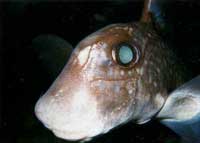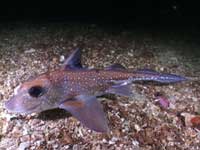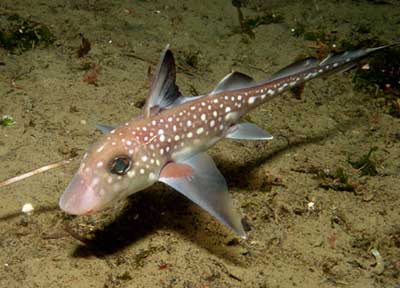 The Hydrolagus colliei, commonly known as the ratfish or spotted ratfish, has a snout and mouth that resemble those of a rat. However, it is not small; it can grow to nearly 1 meter in length.
The Hydrolagus colliei, commonly known as the ratfish or spotted ratfish, has a snout and mouth that resemble those of a rat. However, it is not small; it can grow to nearly 1 meter in length.
The ratfish is easily recognizable by its appearance: it has a long and slender body, a long tail, a large head, and prominent eyes and nose. Its snout is conical; the skin is reddish-brown with lighter spots, and it has smooth, shiny skin without scales.
Ratfish are found in the waters from California to Alaska. They are commonly located in cold waters, typically near the ocean floor at depths ranging from 92 to 913 meters.
This species exhibits many unusual characteristics that set it apart from other fish.
They have large nostrils and suck water through their noses instead of their mouths, as most fish do. Despite being fish, they are not strong swimmers; they use their pectoral fins to move instead of their tails. This unique swimming style gives them a graceful appearance in the water, making them easily detectable.
The primary diet of Hydrolagus colliei consists of crustaceans and small fish. When it comes to feeding, they are quite lazy: they wait for prey to come close before gulping it down, rarely actively swimming to catch their food.
 Their reproductive process is also unique in the fish world. Ratfish are oviparous and undergo internal fertilization. The eggs are laid only after fertilization occurs. The female produces a pouch containing two eggs, which resemble a small violin case made of a hard, horn-like material. The long, pointed eggs can anchor themselves in the sand or mud on the seabed and remain there until they hatch. The time it takes for the female to lay this egg pouch ranges from 18 to 30 hours. Afterward, for about 4 to 6 days, the pouch stays attached to the female’s body by a thin thread. Eventually, the pouch becomes stuck to the ocean floor or embedded in the mud. The eggs take approximately a year to hatch once settled on the seabed.
Their reproductive process is also unique in the fish world. Ratfish are oviparous and undergo internal fertilization. The eggs are laid only after fertilization occurs. The female produces a pouch containing two eggs, which resemble a small violin case made of a hard, horn-like material. The long, pointed eggs can anchor themselves in the sand or mud on the seabed and remain there until they hatch. The time it takes for the female to lay this egg pouch ranges from 18 to 30 hours. Afterward, for about 4 to 6 days, the pouch stays attached to the female’s body by a thin thread. Eventually, the pouch becomes stuck to the ocean floor or embedded in the mud. The eggs take approximately a year to hatch once settled on the seabed.
Divers can cautiously approach ratfish. Typically, this species is not aggressive and prefers to keep its distance from humans. Despite their docile nature, they are related to sharks, and their dorsal spines contain venom that can inflict painful wounds. However, fishermen are more wary of their jaws than their dorsal spines.
During the day, divers find it challenging to get close to them, but at night, ratfish often swim towards bright lights.
Ratfish can be prepared as a specialty food. This type of fish is quite fragile and tends to die easily when out of water. Historically, people have also processed their livers into a type of lubricant oil used for machinery.




















































